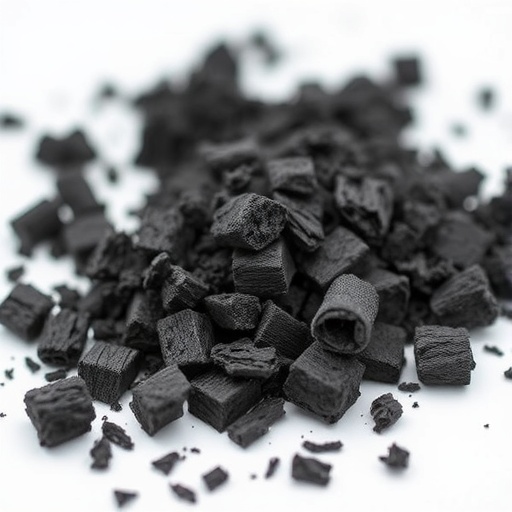In the rapidly evolving world of environmental science, a recent breakthrough has emerged from the study of advanced photocatalytic materials. Conducted by researchers Ajibade and Mbuyazi, the investigation delves into the efficacy of biochar-capped iron oxide nanocomposites in degrading hazardous dyes, specifically malachite green and rhodamine B. These synthetic dyes, commonly used in various industries, pose severe environmental challenges due to their persistence and toxicity, affecting aquatic ecosystems and entering the human food chain. The research represents a significant leap towards developing sustainable solutions for dye degradation in wastewater treatment.
The study focuses on the advantages of photocatalysis, a process where light energy is harnessed to accelerate chemical reactions, facilitating the breakdown of pollutants. This method represents an innovative approach in addressing the growing environmental crisis caused by industrial dye effluents, which have raised alarming concerns among ecologists and environmental chemists alike. By integrating biochar with iron oxide nanoparticles, the researchers aim to enhance the photocatalytic activity, yielding a robust and effective remediation technology for contaminated water.
One of the standout features of this research is its dual approach, involving both single and binary mixtures of the target dyes. Malachite green and rhodamine B were selected not only for their widespread usage but also for their distinct chemical properties, which pose unique challenges for degradation. By investigating both individual and combined degradation processes, the researchers provide valuable insights into the interaction dynamics between different dye molecules, paving the way for more efficient aquatic pollution management strategies.
The biochar used in this study originates from sustainable sources, highlighting the importance of environmental stewardship in its production. Derived from organic materials via pyrolysis, this biochar not only serves as a support for iron oxide nanoparticles but also contributes to carbon sequestration goals. Thus, the incorporation of biochar aligns with current sustainability trends, portraying a holistic approach to pollution treatment that combines waste valorization and contaminant removal.
The results from the photocatalytic degradation experiments reveal compelling evidence of enhanced removal rates for both dyes when subjected to visible light irradiation. The synergy between the biochar matrix and iron oxide nanoparticles significantly boosts the photocatalytic activity, leading to remarkable degradation efficiency. This amplification of performance illustrates the potential of nanocomposite materials, suggesting that they could easily be integrated into existing water treatment frameworks.
The researchers employed various analytical techniques to quantify dye degradation, such as UV-Vis spectroscopy, which enabled them to track absorbance changes over time. This rigorous methodological approach ensures that the findings are both reliable and reproducible, essential qualities for studies aiming to contribute to the scientific literature. Furthermore, the comprehensive dataset generated shed light on the kinetics of the degradation process, which is crucial for scaling up this technology in real-world applications.
Exploring the underlying mechanisms of photocatalysis, the study explains the role of reactive oxygen species (ROS) generated during the photocatalytic process. These highly reactive molecules are pivotal in breaking chemical bonds and facilitating the conversion of complex dye molecules into non-toxic byproducts. Understanding the generation and influence of ROS enhances the potential for optimizing photocatalytic systems for various pollutants beyond dyes.
Moreover, the research highlights the importance of operating conditions such as pH, temperature, and light intensity. These parameters critically affect the performance of photocatalysts and need meticulous control to maximize efficiency. The findings suggest that slight alterations in these conditions can lead to significant variations in degradation rates, emphasizing the necessity of tailoring processes according to specific environmental contexts.
Equally vital is the study’s exploration of the possible environmental implications of using biochar-capped iron oxide nanocomposites. As concerns about the release of nanomaterials into ecosystems grow, the researchers conducted preliminary assessments of the toxicity of the byproducts generated post-degradation. This aspect of the research not only ensures safety but also adds credibility to the proposed technology, reinforcing the commitment to environmentally responsible practices.
Looking ahead, the study underscores the urgency of implementing practical applications of the findings. Urban areas, particularly those near industrial zones, are often grappling with pollution that threatens biodiversity and human health. The development of easy-to-deploy photocatalytic systems could revolutionize the approach to wastewater treatment, thereby becoming an integral part of sustainable urban management strategies.
Furthermore, the research sets the stage for future investigations that could explore other types of pollutants, including pharmaceuticals and heavy metals, as well as the potential for using similar technologies for air pollution control. This broad applicability underscores the versatility of photocatalytic nanocomposites, suggesting they could play vital roles in the fight against multiple forms of environmental degradation.
In conclusion, the work presented by Ajibade and Mbuyazi paves the way for transformative approaches in environmental remediation through innovative materials science. The combination of biochar and iron oxide nanoparticles is not just a methodological advancement; it embodies a burgeoning field that can lead to real-world applications benefiting both society and the planet. By addressing pressing environmental challenges with cutting-edge scientific research, this study represents a beacon of hope in the quest for sustainable solutions to pollution.
As scientists continue to investigate and develop these technologies, the potential for impactful change increases. The integration of advanced materials such as biochar-capped iron oxide nanocomposites into pollution abatement strategies symbolizes the optimism of the environmental science community and the promise of technological innovation to shape a cleaner, more sustainable future.
Subject of Research: Photocatalytic degradation of dyes in wastewater.
Article Title: Photocatalytic degradation of single and binary mixture of malachite green and rhodamine B dyes by biochar-capped iron oxide nanocomposites.
Article References:
Ajibade, P.A., Mbuyazi, T.B. Photocatalytic degradation of single and binary mixture of malachite green and rhodamine B dyes by biochar-capped iron oxide nanocomposites.
Environ Sci Pollut Res (2025). https://doi.org/10.1007/s11356-025-37025-8
Image Credits: AI Generated
DOI:
Keywords: Photocatalysis, biochar, iron oxide nanocomposites, environmental remediation, wastewater treatment, malachite green, rhodamine B, reactive oxygen species, dye degradation, sustainability.




